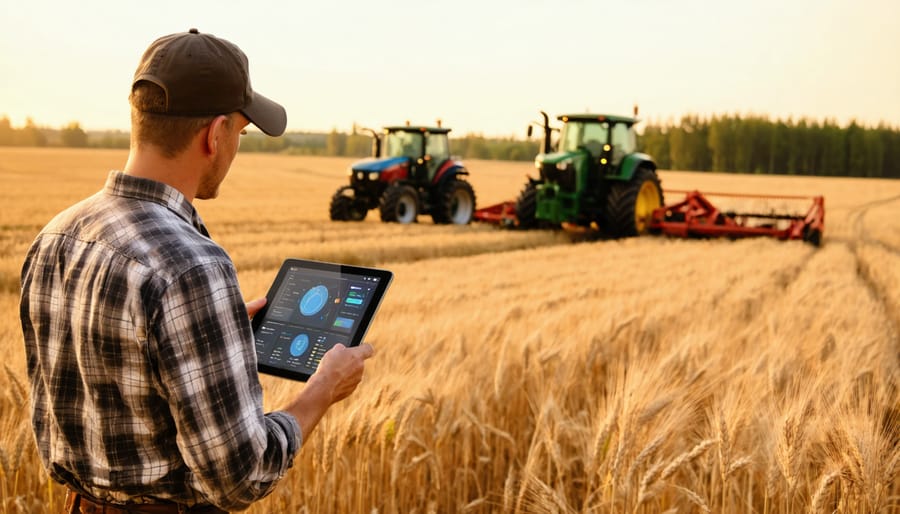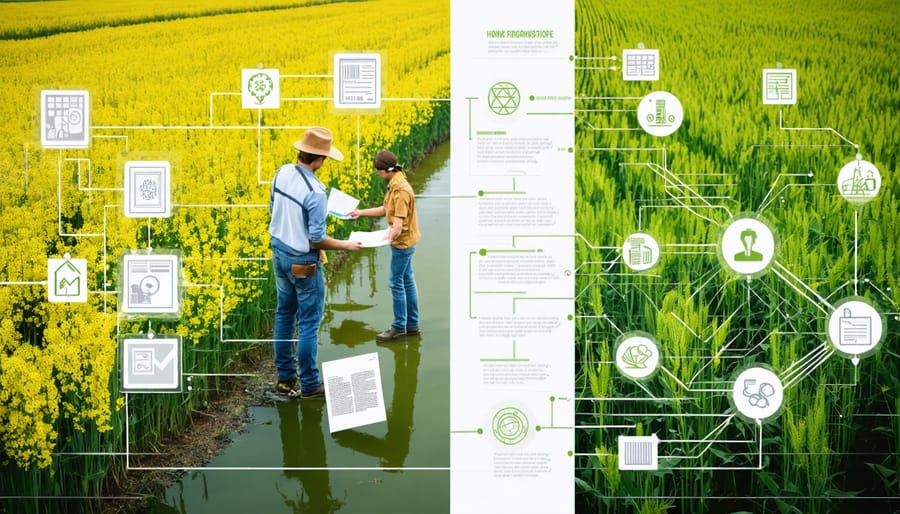Transforming Canadian farmland into sustainable energy hubs stands at the forefront of Alberta’s renewable energy revolution. Across the province’s 50.5 million acres of agricultural land, farmers are pioneering innovative approaches to integrate solar arrays, wind turbines, and biomass systems while maintaining productive cropland. These dual-purpose installations generate clean energy and create additional revenue streams, with average returns of $5,000-$8,000 per hectare annually for participating farms.
The shift toward renewable energy farms represents more than environmental stewardship – it’s reshaping rural economies. Alberta farmers who’ve implemented these systems report 30-40% reductions in operational costs, while contributing enough power to support 100,000 homes across the province. Through strategic placement and modern technology, these installations work in harmony with existing agricultural operations, proving that sustainable energy and profitable farming aren’t mutually exclusive.
For Canadian agricultural communities, renewable energy farms offer a practical path to energy independence while preserving our farming heritage. The integration of these systems demonstrates how traditional agricultural expertise and clean energy innovation can create resilient, future-ready farms.
The Triple Bottom Line: Benefits of Farm-Based Renewable Energy
Environmental Impact
Renewable energy farms play a crucial role in advancing climate solutions in agriculture by significantly reducing carbon emissions. A typical 2-megawatt solar installation on farmland can offset approximately 2,000 tonnes of CO2 annually – equivalent to taking 430 cars off the road. Beyond emissions reduction, these installations help preserve soil health by providing shade and reducing water evaporation. Many Alberta farmers report improved biodiversity around their solar arrays, with native plant species thriving in partially shaded areas. Wind turbines occupy minimal ground space, allowing continued farming activities while generating clean energy. The dual-use approach of combining renewable energy with traditional farming practices creates a sustainable model that benefits both agricultural productivity and environmental conservation.
Economic Advantages
Alberta farmers are discovering significant financial benefits through cutting costs with renewable energy. Initial installation costs are offset by substantial long-term savings on electricity bills, with many farms reporting 40-60% reductions in annual energy expenses. Government incentives, including the Canada Greener Homes Grant and Alberta’s Energy Savings for Business Program, can cover up to 25% of installation costs. Additionally, farmers can generate extra income by selling surplus power back to the grid through net metering programs. Some innovative producers have found success by leasing unused land for solar or wind installations, creating steady passive income streams while maintaining agricultural operations. The decreasing costs of renewable technology, combined with rising traditional energy prices, make these investments increasingly attractive for farm operations of all sizes.
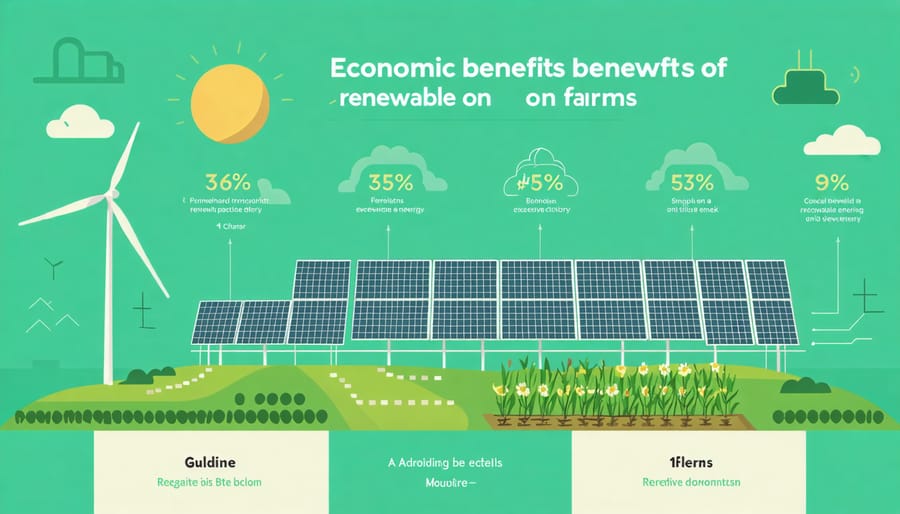
Community Benefits
Renewable energy farms bring substantial benefits to local communities, creating valuable employment opportunities throughout their lifecycle. During construction, projects typically employ local contractors, electricians, and construction workers, while ongoing operations require skilled technicians and maintenance staff. In Alberta, renewable energy projects have created over 2,000 direct jobs in the past five years alone.
Beyond employment, these installations contribute to community energy independence and price stability. Farmers hosting renewable installations often benefit from reduced electricity costs and steady income through land lease agreements. Local businesses frequently see increased activity during construction phases, and municipalities benefit from an expanded tax base that can fund community improvements.
Many renewable farm projects also establish community benefit funds, supporting local initiatives like infrastructure upgrades, educational programs, and environmental conservation efforts. This creates a sustainable cycle of economic growth while reducing the region’s carbon footprint and energy costs.
Popular Renewable Energy Options for Alberta Farms
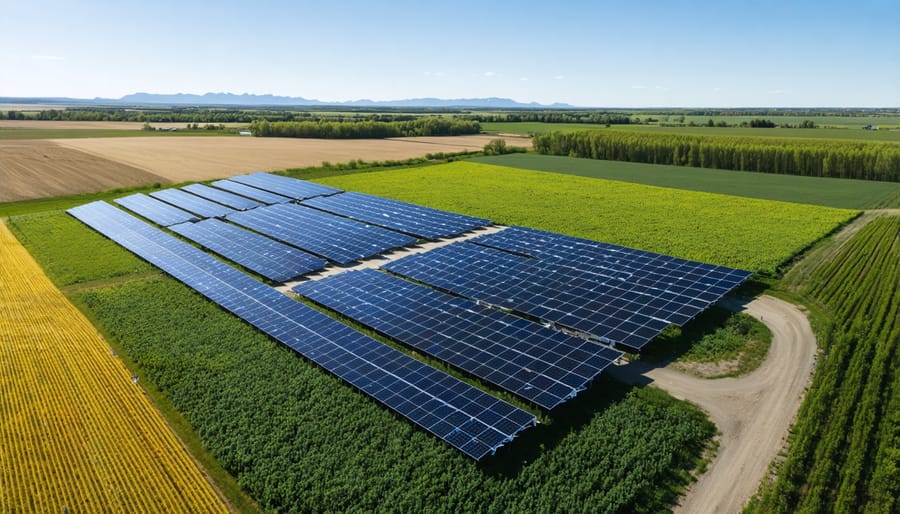
Solar Power Systems
Alberta’s abundant sunlight makes solar power installations an increasingly attractive option for farm operations. Modern solar systems offer multiple configuration choices, from roof-mounted arrays on existing structures to ground-mounted installations in underutilized fields. Recent studies show that Alberta farmers can experience significant solar power investment benefits, with many systems paying for themselves within 8-12 years.
For optimal performance, solar panels should be installed at a 30-45 degree angle, facing south whenever possible. Ground-mounted systems are particularly popular among Alberta farmers, as they allow for easy maintenance and snow removal during winter months. These installations can be placed on less productive land or integrated with grazing areas for sheep, creating dual-purpose spaces.
When planning a solar installation, consider starting with a comprehensive energy audit to determine your farm’s specific needs. Many successful Alberta operations begin with a 10-25 kW system and expand as needed. Local solar contractors familiar with agricultural applications can help design systems that accommodate seasonal usage patterns and withstand our prairie weather conditions.
Key considerations include:
– Available roof or ground space
– Current electrical consumption patterns
– Distance to grid connection points
– Local permitting requirements
– Snow load calculations for mounting systems
Remember to work with certified installers who understand agricultural operations and can provide references from other local farms.
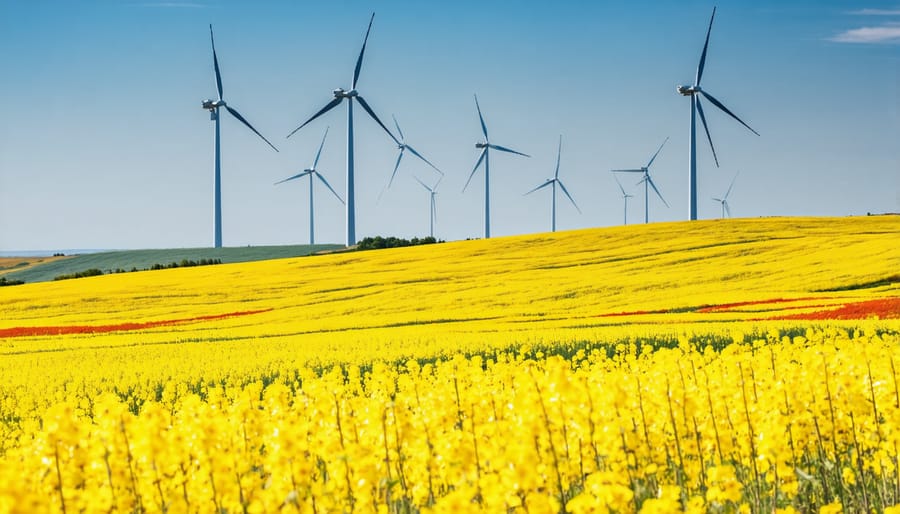
Wind Energy Solutions
Alberta’s vast prairies and open landscapes make it an ideal location for harnessing wind energy, with average wind speeds of 16-20 km/h in many farming regions. For Canadian farmers, wind turbines offer a reliable source of renewable energy that can significantly reduce operational costs while contributing to sustainable agriculture practices.
Modern wind turbines can generate between 2-3 megawatts of power, enough to support multiple farm operations and potentially create additional revenue through power grid feed-in programs. Southern Alberta farmer Jim Anderson shares, “Installing two turbines on my property not only covers our electricity needs but also generates enough surplus to power approximately 50 nearby homes.”
When considering wind energy implementation, start by conducting a wind resource assessment of your property. Local wind patterns, seasonal variations, and landscape features all play crucial roles in determining optimal turbine placement. Many Alberta farmers find success with mid-sized turbines (100-500 kilowatts) that balance power generation with initial investment costs.
The Alberta Wind Energy Association reports that farmers participating in wind energy projects can earn $8,000-15,000 annually per turbine through land lease agreements with energy companies. Additionally, government incentives and grants are available to help offset installation costs, making wind energy an increasingly attractive option for agricultural operations looking to reduce their carbon footprint while maintaining profitability.
Remember to consult with local authorities regarding zoning requirements and environmental assessments before beginning any wind energy project.
Biomass Energy Systems
Converting agricultural waste into energy represents a significant opportunity for Canadian farmers to create sustainable power sources while managing farm residuals effectively. Here in Alberta, biomass energy systems are gaining traction as farmers transform everything from crop residue to livestock manure into valuable energy resources.
The process typically involves collecting agricultural waste materials such as straw, corn stalks, and animal waste, which are then processed through anaerobic digestion or direct combustion. A medium-sized farm can generate enough biomass to power several buildings and potentially feed excess energy back into the grid.
Local success stories include the Lethbridge Biogas facility, which processes over 120,000 tonnes of organic waste annually, generating enough electricity to power 2,800 homes. Many Alberta farmers have installed smaller-scale digesters, converting manure from their dairy or hog operations into both electricity and heating for their facilities.
Getting started with biomass energy doesn’t require massive investment. Many farmers begin with simple systems processing about 20-30 tonnes of waste annually, gradually scaling up as they see returns. The Alberta government offers various incentives and support programs to help offset initial setup costs.
One of the biggest advantages of biomass systems is their reliability – unlike solar or wind power, biomass energy can be generated consistently year-round, providing a steady source of renewable energy while reducing waste management costs and creating valuable by-products like fertilizer.
Real Success Stories: Alberta Farmers Leading the Way
The Miller Family Farm Solar Journey
Located just outside of Olds, Alberta, the Miller Family Farm has become a shining example of successful solar integration in agricultural operations. In 2018, John and Sarah Miller made the decision to install a 75-kilowatt solar array on their 400-hectare mixed farming operation, marking the beginning of their renewable energy journey.
The Millers’ system, consisting of 280 solar panels mounted on their machinery storage building, now generates approximately 85% of their farm’s annual electricity needs. The installation cost $180,000, with 30% covered by provincial renewable energy incentives available at the time. Their return on investment has proven faster than initially projected, with monthly electricity bills reduced by an average of $850.
“We were spending a fortune on power for our grain drying and storage facilities,” explains John Miller. “The solar installation has given us predictable energy costs and actually improved our bottom line.” The system has performed exceptionally well even during Alberta’s winter months, with snow reflection actually boosting energy production on clear days.
The Millers report minimal maintenance requirements, mainly consisting of occasional panel cleaning and routine inspections. They’ve also noticed unexpected benefits, such as the solar panels providing shade for equipment storage and protecting their building’s roof from weather damage. The family now hosts regular farm tours, sharing their experience with other local farmers considering similar investments.
Windcrest Farms: Pioneering Wind Energy
Located just outside of Lethbridge, Alberta, Windcrest Farms has transformed from a traditional wheat operation into a shining example of wind energy integration in agriculture. Owner Sarah McKenzie, a third-generation farmer, partnered with local renewable energy developers in 2018 to install three 2.3-megawatt wind turbines across her 640-hectare property.
The turbines generate enough electricity to power the entire farm operation, including grain storage facilities and irrigation systems, with surplus energy feeding back into the provincial grid. This arrangement provides McKenzie with a stable secondary income stream while maintaining full agricultural production beneath and around the turbines.
“The beauty of wind energy is that it works alongside our farming,” McKenzie explains. “We can still plant and harvest right up to the base of each turbine, losing only about 0.3 hectares per installation.”
The project required an initial investment of $4.2 million, with 30% covered by federal clean energy grants. McKenzie reports an average annual energy cost savings of $42,000, plus additional revenue of $65,000 from power sales to the grid. The system is expected to pay for itself within 8-10 years.
Particularly noteworthy is how Windcrest manages winter operations. The turbines’ advanced cold weather packages ensure reliable performance even during Alberta’s harshest winters, maintaining 95% efficiency in temperatures as low as -30°C.
Getting Started: Your Renewable Energy Farm Plan
Assessment and Planning
Before launching a renewable energy project on your farm, conducting a thorough assessment and developing a detailed implementation plan is crucial for success. Start by evaluating your farm’s natural resources and energy potential through professional site assessments. These assessments typically analyze factors like average wind speeds, solar exposure, available land, and existing infrastructure.
Consider working with local renewable energy consultants who understand Alberta’s unique climate and agricultural landscape. They can help determine which renewable technologies best suit your operation, whether it’s solar panels, wind turbines, or biogas systems. Many Alberta farmers find that a combination of technologies provides the most reliable year-round energy generation.
Your implementation plan should include:
– Detailed cost analysis and return on investment calculations
– Timeline for installation and grid connection
– Required permits and regulatory compliance
– Equipment specifications and supplier selection
– Maintenance schedules and responsibilities
– Safety protocols and staff training requirements
Contact your local agricultural extension office for guidance on available grants and incentives. The Agricultural Financial Services Corporation (AFSC) often provides funding support for renewable energy projects. Remember to engage with your utility provider early to discuss grid connection requirements and potential feed-in tariffs.
Many successful Alberta farmers recommend starting with a smaller pilot project before scaling up. This approach allows you to gain experience with renewable energy systems while managing initial investment risks.
Finding Support and Resources
Implementing a renewable energy farm doesn’t mean going it alone. Alberta farmers have access to numerous support systems and funding opportunities to help make their sustainable energy goals a reality. The Canadian Agricultural Partnership (CAP) offers grants specifically for on-farm energy management and renewable energy projects, with funding up to 50% of eligible costs.
Local agricultural societies and renewable energy associations regularly host workshops and networking events where you can connect with experienced farmers who’ve already made the transition. The Alberta Clean Technology Industry Alliance (ACTia) provides valuable resources and connections to technology providers and industry experts.
For technical guidance, the Alberta Agriculture and Forestry department maintains a network of energy specialists who offer free consultations to help assess your farm’s renewable energy potential. These experts can help you navigate permit requirements, conduct feasibility studies, and develop implementation plans tailored to your specific needs.
Educational resources are available through institutions like Olds College, which offers specialized courses in agricultural technology and renewable energy systems. The Canadian Renewable Energy Association (CanREA) provides comprehensive guides, case studies, and market updates specific to the agricultural sector.
Remember to connect with your local Rural Electrification Association (REA), as many offer member support programs and can share valuable insights about grid integration and infrastructure requirements for your renewable energy project.
The transition to renewable energy on Canadian farms represents a powerful opportunity for our agricultural community to lead in sustainable practices while securing long-term economic benefits. As we’ve seen through successful implementations across Alberta, combining solar panels with crop production or integrating wind turbines with grazing lands isn’t just possible – it’s profitable. By taking advantage of available grants, partnering with local renewable energy experts, and learning from fellow farmers who’ve already made the switch, you can join the growing number of agricultural operations contributing to Canada’s clean energy future. Whether you start small with a single solar installation or develop a comprehensive renewable energy plan, every step counts. Connect with your local agricultural extension office today to explore how renewable energy can work for your farm and help build a more sustainable future for Canadian agriculture.




